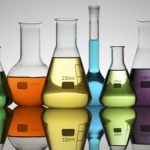Electrolyzed water (EW) is a unique technology that has been gaining popularity in the food industry due to its effectiveness in reducing microbial contamination on food surfaces (Rahman et al., 2016).
EW is produced by passing an electric current through a dilute saltwater solution, resulting in two streams of water: one with a high pH, called alkaline EW (AEW), and another with a low pH, called acidic EW (AcEW). The AEW and AcEW both have strong antimicrobial properties and can be used for a range of food processing applications, such as surface sanitation, cleaning, and preservation.
When a current is passed through a concentrated saltwater solution then hypochlorous acid (HOCl) is produced which is the main sterilization agent. This forms the basis of acidic electrolyzed water (Ac-EW) It is electrically neutral and easily penetrates microbial cell walls where it damages much of the cell’s metabolic enzymes and protein synthesis pathways.
One of the main advantages of EW is its ability to kill a broad range of microorganisms, including bacteria, viruses, and fungi. This makes it a valuable tool in the food industry, where contamination of food surfaces can lead to foodborne illness outbreaks and recalls. Studies have shown that AEW and AcEW are effective against a range of foodborne pathogens, such as Salmonella, E. coli, Listeria, and Staphylococcus aureus. It is most effective against biofilms of Listeria monocytogenes on stainless steel (Kim et al., 2001).
Electrolyzed water is also used effectively for washing vegetables and salads. As a sanitizer it competes with a host of other chemical treatments including sodium hypochlorite (NaOCl), chlorine dioxide (ClO2), hydrogen peroxide (H2O2), various organic acids such as citric acid and lactic acid, gaseous ozone, UV light, sodium bisulphate (NaHSO4), and calcinated calcium (Ca[OCl]2). These have all been used to reduce the microorganisms on fresh vegetables as well as sanitize food equipment surfaces.
Moreover, the use of EW does not require any additional chemicals or preservatives, making it a cost-effective and environmentally friendly solution for food processing facilities.
Electrolysis of Salt & Water
The process involves applying an electric current to a salt (NaCl) solution (typically brine) to split it into useful chemical agents. This is done in a special electrochemical cell with anode and cathode compartments, sometimes separated by a membrane.
What’s in the Mix?
-
Salt (NaCl): Source of sodium (Na⁺) and chloride (Cl⁻) ions.
-
Water (H₂O): Source of hydrogen (H⁺) and hydroxide (OH⁻) ions.
At the Electrodes:
Anode (Positive Electrode) Reactions:
At the anode, chloride ions (Cl⁻) are oxidized:
2Cl⁻ → Cl₂ (chlorine gas) + 2e⁻
Some of that chlorine gas reacts with water to form:
Cl₂ + H₂O ⇌ HOCl (hypochlorous acid) + HCl
Hypochlorous acid (HOCl) is a highly effective, broad-spectrum disinfectant and the main biocidal agent. HOCl is a weak acid with a pKa of about 7.46. When the pH value is low (pH < 4), it is possible to form Cl2 .
Cathode (Negative Electrode) Reactions:
At the cathode, water is reduced:
2H₂O + 2e⁻ → H₂ (hydrogen gas) + 2OH⁻
This produces:
-
Hydrogen gas (H₂)
-
Hydroxide ions (OH⁻), which can react with sodium ions (Na⁺) to form sodium hydroxide (NaOH) — a caustic, alkaline solution.
Main Agents Produced in Electrolysed Water
Depending on pH and system design, you get a mix of:
| Compound | Role | Notes |
|---|---|---|
| HOCl (Hypochlorous acid) | Primary biocide | Strongly antimicrobial, especially at neutral pH |
| Cl₂ (Chlorine gas) | Biocide precursor | Reacts with water to form HOCl |
| NaOH (Sodium hydroxide) | Cleaning agent | Breaks down fats and proteins |
| OCl⁻ (Hypochlorite ion) | Secondary biocide | Formed in alkaline solutions, less effective than HOCl |
| H₂ (Hydrogen gas) | By-product | Must be vented safely |
How ESS Works
Electrolysis Process
-
- A dilute salt solution is introduced into an electrolytic cell. The electrolysis chamber contains a membrane or diaphragm between the positive and negative electrodes of the generator. Some generators have dispensed with diaphragms altogether. These types have come into being because of issues associated with partitioning salt solutions in electrolysis generators.
- The process generates two primary active components:
- Hypochlorous acid (HOCl): A potent yet non-toxic disinfectant.
- Sodium hydroxide (NaOH): A mild cleaning agent.
- The pH, concentration, and balance of these components can be adjusted for specific applications.
- Other free chlorine species are formed including chlorine gas, and –OCl. Also produced is hydrogen peroxide ozone, chlorine dioxide, various radicals including superoxide and hydroxyl radicals (Jeong et al., 2009; Zhang et al., 2018).
- Hypochlorous acid has a very strong antimicrobial effect but will dissociate to hypochlorite (–OCl) between pH 6.5 and 8.5. It will certainly form chlorine gas even at very low acidic pHs below 3 (Rahman et al., 2016). If we sum all the chlorine species they are known as free activated chlorine (FAC) (Gil et al., 2015).
The Use Of Electrolyzed Water In Sterilizing Surfaces
The use of EW in food processing has also been shown to extend the shelf life of fresh produce. For example, research has demonstrated that washing lettuce leaves with AEW or AcEW can reduce the growth of spoilage microorganisms and increase the shelf life of the lettuce by up to five days. Similarly, treating fresh-cut fruits with EW has been shown to reduce microbial growth and extend their shelf life. This can help to reduce food waste and increase profitability for growers and retailers.
Another benefit of EW is its ability to clean and sanitize food processing equipment. AEW and AcEW can be used to clean food contact surfaces, such as cutting boards in the kitchen and conveyor belts, as well as non-food contact surfaces, such as floors and walls. The use of EW for cleaning can help to reduce the risk of cross-contamination and prevent the buildup of biofilms, which can harbor harmful bacteria and other microorganisms.
Despite the many benefits of EW, there are also some challenges associated with its use. One of the main challenges is the need for specialized equipment to produce and distribute the AEW and AcEW solutions. This can be costly and may require significant changes to existing food processing facilities. Additionally, the effectiveness of EW can be affected by factors such as water quality, temperature, and contact time. Therefore, it is important to optimize the use of EW for each specific application and to validate its effectiveness through appropriate testing methods.
In conclusion, electrolyzed water is a promising technology for the food industry, with potential applications for surface sanitation, cleaning, preservation, and shelf-life extension. Its antimicrobial properties make it an effective tool for reducing the risk of foodborne illness and improving food safety. However, the use of EW requires careful consideration of its limitations and proper validation of its effectiveness. As the demand for safe and sustainable food processing continues to grow, the use of electrolyzed water is likely to become an increasingly important tool for food processors and manufacturers.
References
, , . 2005. Enhancing the bactericidal effect of electrolyzed water on Listeria monocytogenes biofilms formed on stainless steel. J Food Prot 68 pp. 1375–80
, , , , . 2003. Effectiveness of electrolyzed acidic water in killing Escherichia coli O157:H7, Salmonella enteritidis and Listeria monocytogenes on the surface of tomatoes. J Food Prot. 66: pp. 542–8
Huang, Y. R., Hung, Y. C., Hsu, S. Y., Huang, Y. W., & Hwang, D. F. (2008). Application of electrolyzed water in the food industry. Food Control, 19(4), pp. 329-345.
Kim, C., Y.-C. Hung, R. E. Brackett, and J. F. Frank. 2001. Inactivation of Listeria monocytogenes biofilms by electrolyzed oxidizing water. J. Food Process. Preservation 25 pp. 91–100
Park, H., Hung, Y. C., & Kim, C. (2002). Effectiveness of electrolyzed water as a sanitizer for treating different surfaces. Journal of Food Protection, 65(8), pp. 1276-1280.
Rahman, S. M. E., Khan, I., & Oh, D. H. (2016). Electrolyzed water as a novel sanitizer in the food industry: current trends and future perspectives. Comprehensive Reviews in Food Science and Food Safety, 15(3), pp. 471-490.
Yan, P., Daliri, E. B. M., & Oh, D. H. (2021). New clinical applications of electrolyzed water: a review. Microorganisms, 9(1), pp. 136



Leave a Reply